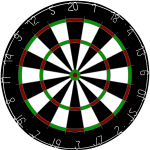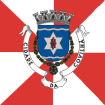Gyronny Cross

By Paul Harding, with
thanks to Sean Wright
for his inspiration.

Gyron
A word with the prefix guro usually means rotation; gyroscope, gyrating, etc.
According to Webster's Revised Unabridged Dictionary, gyron, in the language of heraldry, is:
"A subordinary of triangular form having one of its angles at the fess point and the opposite side at the edge of the escutcheon. When there is only one gyron on the shield it is bounded by two lines drawn from the fess point, one horizontally to the dexter side, and one to the dexter chief corner."
In the language of more common English, that means a right-angled triangle in the top-left quarter of a shield, with its point in the centre of a shield.




Now, the next really useful word to add to our vocabulary is gyronny. This is where we have more than one gyron. You can have as many gyrons as you wish. The dartboard, for example, has ten gyrons, and the shield shown beneath the dartboard has four.
Four gyrons form the centre of a Gyronny Cross (Fr: Croix Gironée). Extending the halves of neighbouring gyrons horizontally and vertically, results in a cross which gives a somewhat bevelled or 3-dimensional appearance. (See the Eastern Orthodox Cross is and other 3-D crosses.)
The Fitched Gyronny Cross, shown on the left, was kindly drawn for us by JS, an aeronautical engineer. (Click the image for a larger view.)
Perhaps more than any other drawing on this page, the Fitched Gyronny Cross has a three-dimensional appearance. As such, this form is often used to depict the Star of Bethlehem at Christmas.
The Gyronny Cross is found in several family coats of arms. In particular, it is displayed in the corporate colours (black and white) used by the Ordo Praedicatorum (Order of Preachers), also known as the Dominicans. (See Dominican Cross)
European Heraldry
Another good example of a Gyronny Cross can be seen on the municipal flag of Covilhã, central Portugal.
A similar cross is used in the emblem of the small town of Zaprešić, Zagreb County, Croatia. Strictly speaking, since the centres of the blue and white crosses do not conform to the required triangular shape, giving them the illusion of depth, in heraldry this is called as the Counterchanged Cross.
But whether we call these a Gyronny Cross, Counterchanged Cross or whatever, doesn't really matter. As with all crosses, there is a deeper meaning than whatever is implied by its name.
Pareidolia – the phenomenon where certain patterns evoke particular interpretations – might lead some to see the four solid triangles as the outline of the swastika. Others may see its more-likely intended meaning as areoplane propellers; i.e. representing rotation.

Croatia
As their coat of arms shows, Croatians love squares and symmetry, but the significance of the blue and white (or silver) is uncertain. The Zaprešić flag was designed when the place acquired its own township status, and this coincided with the 1994 visit to Croatia by the Marian Pope John Paul II. So the colours may have been chosen in honour of the Virgin Mary, who is traditionally associated by blue and white.
US Heraldry
The US Maryland State flag shows two such crosses, which could also be described as Botonée Crosses counterchanged.
This red and white cross was the coat of arms for the Crossland aristocrats in England, whose descendant, the English politician and coloniser George Calvert, sought a royal charter to settle the region of Maryland. His grandson, Leonard Calvert, became the first colonial governor of the state and his great-grandson, Cecil Calvert, became the first Proprietor of the colony. This led to the inclusion of the Crossland emblem in the Maryland flag in 1904. It is the only state flag in the US which is based on a British heraldic emblem.
Red and white happened to be 'secession colours', hence this cross became the banner for Confederate supporters in Maryland.
And finally...
If you've learnt nothing else from this page, at least you might have noticed some new vocabulary.
Thousands of new words are added to English dictionaries every year. Even so, we are sometimes lost for words.
For example, what do you say to that over-enthusiastic artist who, frankly, gives you a headache in your bum, and proudly shows his painting which you find truly appalling. The colours remind you of toe fungus and the subject makes you feel like Lucifer is licking your brain. What do you say? You might manage: "It's interesting" before making an excuse to leave.
Here's a collection of English words that don't exist yet.
Perhaps they should!
Words that don't yet exist
- Aquadextrous: Possessing the ability to turn the bath tap on and off with your toes.
- Carperpetuation: The act, when vacuuming, of running over a piece of string or lint at least a dozen times, reaching over and picking it up, examining it, then putting it back down to give the vacuum cleaner one more chance.
- Disconfect: To sterilize the piece of candy you dropped on the floor by blowing on it, assuming this will somehow 'remove' all the germs.
- Dopeler effect: The tendency of stupid ideas to seem smarter when they come at you rapidly.
- Elbonics: The actions of two people manoeuvring for an armrest in a cinema or plane.
- Frust: The small line of debris that refuses to be swept onto the dust pan and keep backing a person across the room until he finally decides to give up and sweep it under the rug.
- Giraffiti: Vandalism spray-painted very, very high.
- Inoculatte: To take coffee intravenously when you are running late.
- Intaxication: Euphoria at getting a tax refund, which lasts until you realise it was your money to start with.
- Lactomangulation: Manhandling the 'open here' spout on a milk container so badly that one has to resort to the 'illegal' side.
- Peppier: The waiter at a fancy restaurant whose sole purpose seems to be walking around asking diners if they want ground pepper.
- Phonesia: The affliction of dialing a phone number and forgetting whom you were calling just as they answer.
- Pupkus: The moist residue left on a window after a dog presses its nose to it.
- Reintarnation: Coming back to life as a hillbilly.
- Sarchasm: The gulf between the author of sarcastic wit and the person who doesn't get it.
- Telecrastination: The act of always letting the phone ring at least twice before you pick it up, even when you're only six inches away.
- Aibohphobia: A fear of palindromes
New definitions for existing terms
- Claustrophobia: A fear of Father Christmas
- Subordinate Clauses: Santa's little helpers
- Inkling: A baby fountain pen
- Esplanade: To attempt an explanation while drunk
- Negligent: Describes a condition in which you absent-mindedly answer the door in your nightgown
- Lymph: To walk with a lisp
- Flatulence: Emergency vehicle that picks you up after you are run over by a steamroller
- Balderdash: A rapidly receding hairline
- Good health: The slowest possible rate at which one can die
- Nervous wreck: An anxious ship at the bottom of the ocean
- Gargoyle: Olive-flavoured mouthwash
- Psychopath: The route taken by crazy people
- Coffee: The person upon whom one coughs
- Flabbergasted: Appalled over how much weight you have gained
- Abdicate: To give up all hope of ever having a flat stomach
- A short, Straight piece of wood: Half a boomerang
- Monastery: A home for unmarried fathers
- Xenophobic: A fear of starting words with the letter Z
- If lawyers are disbarred and clergymen defrocked, doesn't it follow that electricians can be delighted, musicians denoted, cowboys deranged, models deposed, tree surgeons debarked, and dry cleaners depressed?
Oxymorons
A man walks into a drug store and asks the pharmacist, "Do you have any acetylsalicylic acid?"
"You mean aspirin?" asked the pharmacist.
"That's it, I can never remember that word."
There are lots of long words in English that the Plain English campaigners would like to get rid of. This section shows a few phrases that we use every day, without realising how nonsensical they are. We call these terms 'oxymorons' (or oxymora if you prefer).
An oxymoron is a contradiction in terms, such as "a deafening silence". Here are a few more, with the odd sarcastic crypto-contradiction (non-oxymoron) thrown in for fun.
- Act naturally
- Airline food
- Almost exactly
- Alone together
- American style
- British summer
- Business ethics
- Butt head
- Childproof
- Civil war
- Clearly misunderstood
- Clever fool
- Computer security
- Constant variable
- Definite maybe
- Detailed summary
- Diet ice cream
- English cuisine
- Extensive briefing
- Extinct life
- Female rationality / male sensitivity
- Found missing
- Genuine imitation
- Good grief
- Government initiative
- Government organization
- Humanitarian war
- Jumbo shrimp
- Living dead
- Military intelligence
- Neutral point of view
- New York culture
- "Now, then..."
- Old news
- Only choice
- Original copy
- Paid volunteers
- Passive aggression
- Peace force
- Plastic glasses
- Political correctness
- Pretty ugly
- Random order
- Rap music
- Resident alien
- Rolling stop
- Sanitary landfill
- Small crowd
- Sound of silence
- Sweet sorrow
- Synthetic natural gas
- Taped live
- Temporary tax increase
- Terribly pleased
- Tight slacks
- Twelve-ounce pound cake
- Virtual reality
- Working vacation
The word gyron is related to gore, which is a tapered quadrilateral or triangular gusset sewn into to piece of clothing, sail, etc., to increase the width or change the shape.
Depending on how you "see" things, this might not be a cross at all, but simply two solid blue squares, a blue "L" and an inverted blue "L".
To create this particular design, start with a blue cross on a white field, plus a white cross on a blue field. Then superimpose diagonally opposite quadrants from one to the other. Alternatively, copy'n'paste the image on the right!





